Matador Network's Blog
September 26, 2025
A Dog’s-Eye View of The Cabins at Disney’s Fort Wilderness Resort

Attention, readers: You’ll have to forgive any typos in this article. My paws aren’t great on a keyboard. But I couldn’t leave it to my humans to write this story.
Visiting Walt Disney World® Resort with family adds extra magic to your vacation at The Most Magical Place on Earth. For families like mine, that includes wagging tails — and nothing makes my tail wag like staying at The Cabins at Disney’s Fort Wilderness Resort. The Resort is a great place for dogs like me to stretch their legs, make new friends at the dog park, and spend time with their family in a cozy cabin.
Just a short boat ride from Magic Kingdom® Park, Disney’s Fort Wilderness Resort & Campground feels like its own world. Located on 750 acres of pine and cypress woods — with dog-friendly nature trails, colorful cabins, and dedicated dog parks — it’s a place where pups like me can feel the magic of Disney, too.
Sniff Check: Settling in at the ResortWhen my family arrived, we stopped by the Reception Outpost to show proof of my vaccinations and pick up Pluto’s Welcome Kit. Inside the reusable Disney bag was a collection of my very own goodies: a dog bowl, a dog tag, a bone-shaped placemat, and a door hanger so that housekeeping would know I was in our cabin. (My humans could also dial the housekeeping button on the cabin phone to schedule a cleaning time.)
With complimentary waste bags and a map of the campground, my family and I charted our course to Waggin’ Trails Dog Park. It has separate fenced sections for larger dogs and smaller pups and is a fun place to run around off-leash.
Of course, I didn’t mind exploring the rest of the Resort’s tree-lined walking paths with my leash on. I could tell my humans were already planning all the things they’d get up to: archery lessons, canoe rides, horseback riding — even a golf cart rental so we could move around in style. There was excitement in the air (and a lot of new smells, too).
Cabin Comforts: A Pawfect Stay for the Whole FamilyDisney’s Fort Wilderness Resort has more than 400 cabins, and I’m happy to report that all of them are dog-friendly (two pups maximum, with an additional fee). My family said they loved how the cabins are all new, made with a nature-inspired, modern design that focuses on sustainability. (I’m not exactly sure what “sustainability” means, but if it involves extra belly rubs and more squirrels to chase, I’m all for it.)
Each cabin can sleep six humans, with plenty of space in the living room and on the patio. Everyone in my family had their own bed, including bunk beds decorated with lanterns and canoe paddles inspired by some of your favorite Disney pals. Even though I wasn’t allowed on the furniture (sigh), I loved curling up by the floor-to-ceiling windows with my own front-row view of the trees and all that Florida sunshine.
Sometimes I’d nap while my family gathered in the kitchen and dining area (just like they do at home) or around the picnic table and patio grill. In the evenings, once my family was back from an action-packed Theme Park day, our cabin was the perfect place to spend quality time together, watch Disney movies (Lady and the Tramp and 101 Dalmatians are my favorites), and enjoy some belly rubs. No matter the hour, it really felt like our own little retreat in the woods.
Exploring the Resort: The Magic Goes FurtherDogs can’t go to restaurants or pool areas, of course, but I loved watching my family get ready for their adventures. One morning, they trotted off for a horseback riding session at Tri-Circle-D Ranch — I barked them a good-luck sendoff. Another day, they splashed around the Meadow Swimmin’ Pool, zipping down the waterslide and soaking in the whirlpool spa. There’s even a splash pad there for the smaller pups (well, the human ones, that is).
There was also so much for us to see and do together. When I wasn’t zooming around at Waggin’ Trails Dog Park or getting my paws dirty on the trails, we loved riding our golf cart around the campground, seeing all the decorations that other families put up at their campsites, and waving to Characters like Chip ‘n’ Dale. As for doing my business, there were dog relief areas located on every cabin loop. How thoughtful is that?
Walt Disney World® Resort is magical for the whole family and thanks to The Cabins at Disney’s Fort Wilderness Resort, it’s an experience we get to share together — wagging tails included. 
As to Disney properties/artwork: ©Disney
Disney’s Outdoor Adventures You Never Knew Existed

Most people don’t come to Walt Disney World® Resort expecting archery lessons, trail rides, or kayaking adventures. You might not even realize you can do all that — and more — right around the corner from your favorite Disney Parks. At The Cabins at Disney’s Fort Wilderness Resort, an idyllic woodland hideaway within Walt Disney World® Resort, the great outdoors gets a touch of enchantment — the kind where slow mornings turn into spontaneous adventures, Chip ‘n’ Dale host evening campfires, and memorable moments are forged on the front porch.
When you stay at The Cabins at Disney’s Fort Wilderness Resort, here’s what’s waiting outside your cabin door:
Paddling through lakes and streamsMany lakes, ponds, and streams in Central Florida are good for paddling, and Disney’s Fort Wilderness Resort & Campground is no exception. Rent a canoe or kayak at the Bike Barn near the Meadow Swimmin’ Pool, launch into the Resort’s tranquil waterways, and glide among cypress trees, waterfowl, and other wildlife. You might even spot a real-life Bambi along the way.
Putting your fishing skills to the testThe same waterways that are perfect for paddling are also great for casting a line. Enjoy dockside fishing on your own, grabbing all the gear you need from the Bike Barn, or book a guided fishing excursion from Fort Wilderness Marina. Either way, you’ll be reeling in largemouth bass (and releasing them, per Walt Disney World® Resort’s policy).
Pedaling through the pinesNaturally, the Bike Barn also has bicycles for rent — perfect for exploring the flora-filled grounds by land. Once you lace up your closed-toed shoes, you’ve got options: stick to the popular, paved one-mile bike path, which runs around the perimeter of the Resort and to the nearby Disney’s Wilderness Lodge, or take to the many off-road trails, winding between pine trees and palmettos.
Navigating trails on an all-terrain Segway® X2 or a golf cartOne of the most unique activities at Disney’s Fort Wilderness Resort, the guided Wilderness Back Trail Adventure takes Guests ages 16 and older on all-terrain Segway® X2s through the Resort’s scenic backwoods. You’ll maneuver your way on paved paths and woodland trails alike, stopping for photos with the horses at Tri-Circle-D Ranch and the beautiful Bay Lake. As if all the natural beauty wasn’t enough on its own, your guide will share Disney and nature-based fun facts along the way. It’s safe to say, there’s nothing quite like this off-roading adventure anywhere else at Walt Disney World® Resort.
Looking for another unique way to get around Disney’s Fort Wilderness Resort? Rent a golf cart for your crew and decorate it to add a touch of personal style to your trail transport. It’s practically a Resort tradition.
Saddling up for a scenic horseback rideAfter catching a glimpse of the Tri-Circle-D Ranch during the Wilderness Back Trail Adventure, plan a proper visit to make a new equestrian friend. Home to nearly 100 happy horses, this ranch is a dream for animal lovers. Stop by to say hello or book a trail ride (limited to Guests ages nine and older who are at least 48 inches tall) to explore the beauty of the Resort on horseback. As you trot through Florida woodlands, keep your eyes peeled for deer, rabbits, ducks, and more.
If younger riders want their own equestrian experience, the Resort also offers pony rides for kids between ages three and nine. Once your little one is saddled up, an adult from your party will lead the pony around a designated course. It’s a perfect gentle introduction to the joys of horseback riding, Disney style.
Enjoying a storybook carriage rideWant to get a taste of what it feels like to be a Disney Princess? Swap the saddle for a carriage seat on one of Tri-Circle-D Ranch’s in-demand carriage rides. During the 25-minute ride, you and your group will meander through the nature oasis that is Disney’s Fort Wilderness Resort. And if you happen to be visiting for the holidays, the festive décor — and alternative sleigh ride setup — make the experience all the merrier.
Trying your hand at archeryArchery is one of the Resort’s most popular activities — and for good reason. Officially called the Fort Wilderness Archery Experience, it allows Guests ages seven and older to learn how to use a compound bow with the help of an experienced instructor. Before you know it, you’ll be hitting the bullseye.
Toasting marshmallows with cheeky chipmunksThe Chip ‘n’ Dale Campfire Sing-A-Long is another Resort favorite. Most nights at 8 PM, Guests gather ‘round the campfire for s’mores and campfire songs while our chipmunk friends, Chip ‘n’ Dale, make appearances at the cozy, crackling event. Stick around after the sing-along for a family-friendly Disney movie under the stars.
Watching Bay Lake light upThe nightly Electrical Water Pageant® (weather permitting) is a brightly lit water parade that winds its way around Seven Seas Lagoon and Bay Lake. You’re so close to the magic at Disney’s Fort Wilderness Resort that you’ll have a front-row seat for the show. Find a spot at Clementine Beach and enjoy the sight of twinkling floats drifting by. This is also a great spot for catching the fireworks at Magic Kingdom® Park.
Settling in at the coziest of cabinsAfter a day filled with outdoor adventure, The Cabins at Disney’s Fort Wilderness Resort are the perfect place to come “home” to. Each of the modern cabins sleeps six, with plenty of room for the whole family and all kinds of comfortable amenities — a full kitchen and dining area, a private patio with a charcoal grill and picnic table, and floor-to-ceiling windows, to name a few.
It’s the ideal blend of nature and indulgence — and it’s just a short bus or boat ride away from the Theme Parks, making it easy to add even more Disney magic to your already enchanting wilderness itinerary. 
Certain activities and experiences require additional fees and reservations may be necessary.
As to Disney properties/artwork: ©Disney
9 Reasons to Stay at The Cabins at Disney’s Fort Wilderness Resort on Your Next Trip to Orlando

Disney’s Fort Wilderness Resort & Campground has been a favorite destination for Guests on a Disney vacation for more than 50 years. In 2024, The Cabins at Disney’s Fort Wilderness Resort debuted, providing a sleek new lodging option and making now the perfect time to go. Tucked within 750 acres of Florida pine and cypress groves, each cabin has a full kitchen, spacious living area, dining area, full-sized bathroom, and enough space to sleep an entire Disney-loving crew. It’s an ideal spot for your home-away-from-home experience. Here’s what else you can expect to fall in love with during your getaway to The Cabins at Disney’s Fort Wilderness Resort.
1. It’s a forested oasis in the heart of the magic.Staying at The Cabins at Disney’s Fort Wilderness Resort feels like you’ve traveled into the wilderness, but the entrance to Magic Kingdom® Park is just a few miles away. Multiple modes of transport depart every few minutes, so you can wander between Theme Park thrills and woodland tranquility on your own schedule. Picture this: You stroll down to a scenic dock, climb aboard a comfortable boat, and cruise along while taking in gorgeous views of Bay Lake as you ride to Magic Kingdom® Park. At night, return to the shore and watch the Electrical Water Pageant, a floating nighttime parade.
In addition to the boat service to Magic Kingdom® Park, there are complimentary buses to EPCOT®, Disney’s Hollywood Studios®, Disney’s Animal Kingdom® Theme Park, and Disney Springs®. Boat and bus service schedules start before the Parks open and run until late evening, so you can visit the Parks for the full day before returning.
2. There’s no shortage of classic camp activities.During your stay, you can learn archery, cast a line for some catch-and-release fishing, saddle up on a forested trail ride (where you can meet Cinderella’s ponies), and take part in other hands-on experiences. In addition to joining a guided activity, you can set off on your own adventure on the Resort’s six-plus miles of trails that wind through pine flatwoods and along the edge of Bay Lake. Want to cover more ground with less effort? Join in the Disney’s Fort Wilderness Resort tradition of renting and decorating a Golf Cart to get around in style.
3. Exciting Disney entertainment happens right at the Resort.In true Disney fashion, you’ll have plenty of opportunities to meet Characters, including around Chip ‘n’ Dale’s Campfire Sing-A-Long most nights (think roasting marshmallows, sing-alongs to folk favorites, and photo opportunities with the mischievous chipmunks). You can also reserve seats at Hoop-Dee-Doo Musical Revue, an all-you-care-to-enjoy country-style feast paired with high-spirited performances. Chow down on fried chicken, BBQ ribs, a range of sides, and a delectable strawberry shortcake dessert as you take in the show.
4. You have your pick of pools.When you’re ready to cool off, check out the Resort’s Meadow Swimmin’ Pool, with its 67-foot corkscrew waterslide, whirlpool spa, and fort-themed splash zone for kids. There’s also the smaller, adult-centric Wilderness Swimmin’ Pool for a quieter soak. Both pools operate year-round with lifeguards on duty to keep a watchful eye over everyone.
5. The family can head to the lake for a good time.Another option is to head over to the rental shop and pick up a single or double kayak, canoe, or paddleboard for self-guided fun through the Resort’s many coves and marshy inlets. Wildlife watchers may even spot a few herons, turtles, and bass as they glide past the sandy shoreline.
6. The cabins are way more spacious than you might expect.Don’t let the word “cabin” fool you. These one-bedroom accommodations at The Cabins at Disney’s Fort Wilderness Resort are both adorably chic on the outside and surprisingly spacious on the inside. Each sleeps up to six people, thanks to the queen-sized bed, twin-over-twin bunk beds, and full Murphy bed. They have vaulted ceilings and floor-to-ceiling windows that frame those coveted forest vistas, along with sit-down dining areas and living-room seating — perfect for spreading out or getting cozy, depending on the mood. And yes, each cabin comes with air conditioning, so you’re guaranteed a great night’s sleep to rest up for tomorrow’s adventures.
7. You’ll have everything you need to cook at “home.”Channel your inner chef in the cabin’s full kitchen and dining area, whether you’re flipping pancakes for breakfast or grilling dinner on your private patio. Dine al fresco to take advantage of the warm Florida evenings, laugh around the picnic table, and create the kind of memories that only come together when everything you need is right at your fingertips.
8. The Resort’s dining options can make mealtime simple.Guests who want to sit back and relax can leave the heavy lifting to the Resort’s chefs when it comes to meals. Head to Trail’s End Restaurant for quick-service options (shout out to the fan-favorite strawberry shortcake). For a sit-down experience, make your way over to Crockett’s Tavern. The restaurant’s refreshed menu includes comfort-food dishes like Burnt Ends Macaroni & Cheese and House-smoked Beef Brisket Sliders, along with the must-try Old-fashioned Buttermilk Pie with seasonal topping.
9. Dogs are welcome, too.Last but not least, family fun means the entire family at this Resort. Guests at Disney’s Fort Wilderness Resort can bring up to two dogs (subject to an additional fee), who are welcome to explore along the leash-designated trails or in the off-leash Waggin’ Trails Dog Park. It’s the perfect way to make lasting memories for you, your kids, and your four-legged friends on your next Orlando vacation. 
Certain activities and experiences require additional fees and reservations may be necessary.
As to Disney properties/artwork: ©Disney
September 25, 2025
Your Selfie in Front of Canada’s Glaciers Could Help Save the Planet

It’s been estimated that humans take up to 92 million selfies a day — and that was back in 2022. And when travelers are exploring new places, they probably take more than their fair share of selfies and destination photos. Now, in western Canada, five wel-known parks are taking advantage of that desire to capture the moment by asking visitors to share their glacier selfies with researchers. It ensures each visit leaves behind something more meaningful than footprints: environmental data.
Launched this year, “GlacierReach” is a community science program that enlists everyday park visitors to monitor rapidly disappearing glaciers in Canada’s Glacier National Park and Jasper National Park. It’s a partnership between the Government of Canada, Parks Canada, BC Parks, the BC Parks Foundation, and the University of Waterloo, and ensures every photo shared becomes an important piece of data. It’s also called the “Icy Initiative,” because rather than encouraging travelers to take photos of themselves — selfies — they’re asked to take photos of the ice — hence, “icies.” (But it’s okay if you’re in it, as long as you can see the glacier, too).

Photo: Parks Canada/Luuk Wijk
At glacier viewpoints in the two national parks, as well as Bugaboo, Garibaldi, and Mount Robson provincial parks in BC, visitors will find one to three “Icy Stands” at viewpoints in front of the parks’ glacier lookouts. Each stand has a sturdy phone mount in a fixed location, creating a straightforward process: Set your phone in the holder, snap a photo of the glacier, and upload it immediately via a QR code on the stand or later through the GlacierReach website. The fixed angle of the phone stands ensures each photo is from the exact same angle, and thanks to location data, researchers can use the images to build a time-lapse visual record of changes in the glaciers, like retreats, thinning, or breakage.
“Glaciers are remarkable features of B.C.’s provincial parks,” said Minister Tamara Davidson of BC Parks’ Ministry of Environment and Parks, in the program announcement. She calls the initiative “community research in action.” “When the public engages with science, it deepens our understanding of these rapidly changing landscapes,” she said, “which has never been more important.”
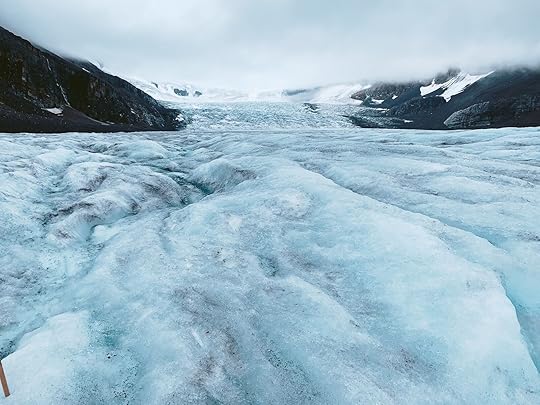
Athabasca Glacier, Summer 2019. Photo: Suzie Dundas
Canada is home to some of the largest concentrations of ice outside of the polar regions. The glaciers store huge amounts of fresh water, feeding rivers and entire ecosystems in the summer, supporting communities and agricultural regions.
Western Canada’s glaciers are disappearing at alarming speed. Recent measurements at Jasper’s Athabasca Glacier, which has been receding for roughly 125 years, showed more ice loss in 2023 than in the entire decade before that. Glaciers in Glacier National Park are melting faster than anywhere else in Canada, with the park’s Illecillewaet Glacier retreating an average of 34.9 feet per year since 1887. Glaciers in British Columbia’s provincial parks are also at risk, with estimates showing that the ice cover in Garibaldi Provincial Park has decreased by more than 51 percent since the late 1800s.
For scientists, it’s nearly impossible to monitor Canada’s thousands of square miles of glacial cover. But each photo from the various Icy Stands will act as a real-time visual report, helping researchers track changes in the park landscapes. So if you’ve ever felt self-conscious about taking a photo or selfie when traveling, don’t — your quick snap could be critical to the future of climate change action. You can feel good knowing your photo ended up in an important scientific database, rather than just your Instagram feed. 
September 24, 2025
The Travel-Ready Running Kit That Got Me Out of the Hotel Gym

It sounds strange for such a simple activity, but having the right gear makes a huge difference when running. I’m a lifelong snowboarder and at 41, my knees, to put it gently, aren’t what they used to be. I’ve always desired the activity’s benefits – the improved cardiovascular health, the boosted metabolism, and the famed “runner’s high” that leaves one breathless but stoked beyond comparison after a jaunt on the trail or pavement. I travel frequently for work and have long wanted running to complement the inconsistent quality of hotel gyms as a source of exercise while on the road. But I’ve never been able to make it more than a mile without experiencing significant knee pain. Every so often I try, and each time I spend the following couple days cringing and hating myself at every step.
Then a friend introduced me to the Altra Experience Wild 2 trail running shoe, which kickstarted for me a quest to obtain good running gear that has subsequently changed both my experience and perception of the sport. I’ve since acquired running clothes from Roark’s Run Amok collection, and Stance Light Performance Crew Socks for a complete setup of basic running attire. Combined, these pieces of gear have reframed an activity I’d long thought couldn’t work for me, and given me one more reason to skip the hotel gym altogether.
We hope you love the travel-ready running gear we recommend! Just so you know, Matador may collect a small commission from the links on this page if you decide to make a purchase.
Where and how I tested this stuffGetting into the swing – er, run – of thingsI live in the high-desert of western Colorado, in a county that is 70 percent public lands. As such, trails abound – from the alpine of the Grand Mesa to the deserts of Fruita. I tested the Altra Experience Wild 2 shoes and the Roark Run Amok gear in both alpine and desert environments, primarily on the Lunch Loops trail system in Grand Junction. I chose this system because it’s rocky and technical, with moderate but not severe elevation gain. This allowed me to learn how the shoes, in particular, performed on uneven surfaces. Also, it’s frickin’ hot here in the summer (above 90 degrees daily in July and August), and most of my runs were in the afternoon heat. This allowed me to get a good feel for the ventilation and circulation, as well as the breathability, of the Roark Run Amok products. Additionally, I brought the gear on work trips to Detroit and to Providence, Rhode Island, to gauge how well it all traveled, including how much space it took up in my roller bag.
My runs varied in length from 2.4 miles to five miles. I did some 10 runs over six weeks as part of the testing.
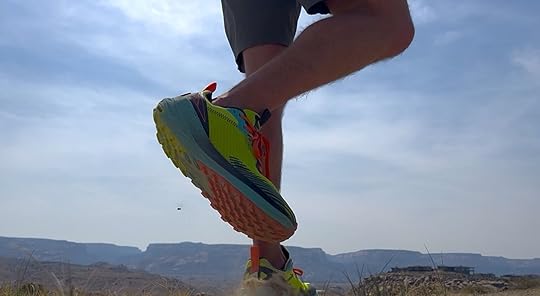 The Altra Experience 2 trail running shoes provide ample padding on the heal and a wide toe box. Photo: Tim Wenger
The Altra Experience 2 trail running shoes provide ample padding on the heal and a wide toe box. Photo: Tim Wenger The Altra Experience 2 trail running shoes helped me train my brain to land on the heel and roll forward, rather than the other way around. Photo: Tim Wenger
The Altra Experience 2 trail running shoes helped me train my brain to land on the heel and roll forward, rather than the other way around. Photo: Tim Wenger The Altra Experience 2 trail running shoe turned this non-runner into a runner. Photo: Tim Wenger
The Altra Experience 2 trail running shoe turned this non-runner into a runner. Photo: Tim WengerThe Altra Experience Wild 2 trail running shoes ($140 at REI) upped the game for me immediately. Altra is doing cool stuff to make running a more inclusive community, and a bit of research on the brand and its products, along with an additional recommendation from a guy at my coworking space who is training for a marathon, made clear that this is the brand I want to support if I’m going to make space in my mud room for a pair of running shoes. The wide toe box prevented the bunion on my right foot from constantly scraping the side of the shoe, something that has been a consistent issue with hiking boots and shoes in the past. The heel is buffered, providing a soft landing after each step that prevents me from leaning into my toes. After some six or seven good runs in the Altra shoes I’ve learned that leaning into my toes was part of the reason I was experiencing significant knee pain before. The shoes have retrained my brain to not land on my toes and roll my feet backward when I run, but rather to do the opposite. This results in less strain on the front of my feet, and makes the entire running process less painful. I also feel significantly less sore than I did before acquiring these shoes.
When I first began this testing I was running two to 2.5 miles and still felt significant pain and soreness in my knees in the couple days that followed. After two runs this pain went down noticeably and became more of a slight soreness that could be worked out with some good stretching. My fifth run at Lunch Loops was accented by a significant downpour. It started slow with a drizzle, but by halfway through the run I was drenched and the trail had become muddy and sticky. The shoes seemed to minimize the stickiness and, most importantly, kept me from sliding or slipping. I did, however, slow down each time I crossed a big rock or came to a step down.
The shoes feel quite bouncy on the step, cushioning the impact and then helping to launch the foot back up again. I’m admittedly not embedded into the “running community” and don’t have much frame of reference, but prior to owning these shoes the thought of running a 5k seemed like a tall order. After my first run in the Altra Experience Wild 2 trail running shoes I’m confident I could accomplish this tomorrow.
Completing my travel-ready running setupAt least 50 percent of my (admittedly minimalist) wardrobe consists of Roark clothes, from the brand’s travel pants to its t-shirts and button-downs. The travel-guide-esque catalogues the company sends in the mail along with the extensive collection of documentary-style travel videos it produces increasingly lean into the “Run Amok” collection, a line of clothing designed for running (often distances much further than what I will ever accomplish). Since I already trust the company’s travel-ready clothing, I opted for the Alta 5” run shorts and the Mathis Active Pocket Tee. I also grabbed a pair of Light Performance Crew socks from Stance, which I chose because they’re thicker than typical crew socks (and the brand’s Ultralight crews) but still thin enough to not encase my feet in sweat after half a mile, as had been a problem running in standard hiking socks.
Upon first stepping into the Alta shorts ($89), I was reminded of the day in 6th grade when I arrived to my middle school bus stop wearing what weren’t acceptably plumed shorts (those were the days of JNCOs) only to have a kid yell “TIM WEARS SHORT SHORTS!!!!” in front of everyone. This time around I had the benefits of a) wanting to wear short shorts for breathability in the 90-degree heat, and b) the apparent fascination of Gen Z men with showing off the upper thigh, to prevent any verbal ridicule. The breathability immediately worked to my benefit. It kept me cool as I ascended a few hundred feet to the top of the Curt’s Lane trail. The shorts feature a zippered pocket in the back for a car key and phone. I learned not to put a full key ring in there otherwise I’d get poked in the lower back repeatedly, but the pocket works well for the bare essentials. There’s no pocket space beyond that one. The shorts held tight to my hips the entire time, and I appreciated the oxygen flow and minimalism of them.
 Roark's Alta running shorts are super breathable. Photo: Tim Wenger
Roark's Alta running shorts are super breathable. Photo: Tim Wenger Roark Run Amok running gear remained breathable and comfy, even on 90-degree runs. Photo: Tim Wenger
Roark Run Amok running gear remained breathable and comfy, even on 90-degree runs. Photo: Tim Wenger Who wears short shorts? Photo: Tim Wenger
Who wears short shorts? Photo: Tim WengerMeanwhile, the Mathis tee ($59) features “DriRelease” jersey knit that wicked the sweat from my chest and back, regulating the heat quite well, and was loose enough that I could use it to easily and frequently wipe the sweat from my brow without having to stop or even slow down. The Stance Light socks ($54.99 for a 3-pack) worked alongside the wide toe box of the Altra shoes to keep my bunion in check. They’re made of soft cotton and feature the brand’s Infiknit reinforced heels, which also complemented the boots’ padded heel. The combination of these two pieces of gear seemed to be what really saved my knees. Each time I arrived back at the trailhead my feet were the least-sweaty part of my body, which I’ll count as a win.
What I gained most through this experiment was perspective. Prior to that first run, I had no concept of how intense a marathon is or how doable a 5k might be. That first 2.4 miles cast a new light on terms and topics I’ve heard about all my life, but had never been able to discuss with any earned knowledge. Something I’d long thought I couldn’t do has become an exercise tactic I now hold in my pocket for travel, able to deploy early in the morning on work trips or after long days when I can’t make it to the hotel gym. As a bonus, by wearing the shoes on the plane (far more comfortable than wearing boots or even my typical skate shoes) I don’t even have to sacrifice any room in my roller bag. 
Dubai Is Getting Mandarin Oriental’s First-Ever Golf Resort

Mandarin Oriental is taking a swing at Dubai’s next big lifestyle district with Mandarin Oriental Jumeirah Golf Estates — the brand’s first dedicated golf resort with branded residences and its third address in the city, opening in 2030. The site sits in the south-west of Dubai at Jumeirah Golf Estates’ expansion, known as the Next Chapter, and promises a clear split in focus: precision on the fairways, restoration in the spa, and family time in between.
The numbers are straightforward. The resort will have 121 rooms and suites, plus 97 branded residences spanning three to six bedrooms — each residence with its own lounge, meeting space, pool, and fitness areas. Wellness is the headline: nearly 5,000 square meters dedicated to The Spa at Mandarin Oriental, with male- and female-only pools, an outdoor meditation zone, a barber and a salon, and three additional swimming pools. Six dining venues are planned, including two at the Golf Club and a Halfway Hut on the course, alongside a ballroom and outdoor event spaces.
Beyond the resort boundary, guests will tap into Jumeirah Golf Estates’ broader buildout: an 18-hole championship course, a driving range, an academy, and agronomy programs anchored by a full clubhouse with a pro shop, sports bar, gym, and extensive lockers. A 7,000-square-meter equestrian center and clubhouse brings indoor and outdoor arenas, training facilities, stabling, retail, and riding trails. For families, there’s a fully serviced indoor-outdoor kids’ club and a nursery on site.
The move rounds out a three-part Dubai portfolio strategy — beach, downtown, and now golf — that Mandarin Oriental’s chief executive, Laurent Kleitman, framed as complementary identities across the city in an interview with The National. The new property will sit near two championship courses and reiterated the scale of the wellness and equestrian facilities, underscoring where the resort intends to compete.
There will be a strong connection to the rest of the city according to the Next Chapter’s masterplan, which notes plans for Etihad Rail access and a new Dubai Metro station within the district. There’s also a proposed 5,000-seat tennis stadium, a signal that the area is being built for multi-sport itineraries, not golf alone. 
Can’t Attend Fat Bear Week? 6 Other Places to See Chunky Bears at Their Best.

Every October, Katmai National Park in Alaska turns into the internet’s most adorable battleground: Fat Bear Week. The seven-day competition sees the park’s beloved coastal brown bears (grizzlies) competing for fan votes in a bracket-style tournament. While the winner is usually the chunkiest of the chunky, it’s up to fans around the world to decide. It was started by park rangers in 2014 to educate people about bear biology, but quickly grew into an international phenomenon adored by millions. In 2024, more than one million votes were cast, with a bear named Grazer winning for the second time in a row.

Bear viewing at Brooks Falls. Photo: NPS/M. Whalen/Public domain
Anyone can vote, even if you can’t see the bears in person. But if you do want to see bears in person, getting to Katmai isn’t the easiest. You’ll need to first get to Anchorage, Alaska, then book a bear-viewing day trip. They typically cost $900 to $1,400 per person and usually include an early morning flight from Anchorage to King Salmon, a floatplane into Brooks Camp, about four to six hours of bear viewing, then flights back in the evening. However, they can book months in advance, especially during Fat Bear Week. And if the bear-viewing platforms at Brooks Camp are busy, you’ll need to be patient, as rangers limit how many people can be on the platform and how long they can stay.
Fortunately, if you can’t make it to Katmai for Fat Bear Week, there are plenty of other places to see brown bears living their best (i.e., chunkiest) lives in the fall.

Grizzly bear in the Bute Inlet. Photo: David Maki Photography/Shutterstock
Bute Inlet, in the southern part of British Columbia’s Great Bear Rainforest, is one of the most reliable places to see grizzlies in the wild. Every fall, the salmon run draws bears to the rivers for fishing, fighting, and otherwise fattening up. There are elevated viewing platforms for visitors, and bears have been known to get extremely close. It’s remote, but its proximity to Vancouver Island makes it easy to visit in a day.
Most travelers reach Bute Inlet via boat tours from Campbell River on Vancouver Island. The boat trip is roughly two hours each way (with whale sightings very common), with about three hours of bear viewing on land. Bute Inlet is Klahoose First Nations territory, and guides will usually share information about the cultural and traditional significance of bears and their habitat. Tours typically run through mid-October. Tours start at under $500 per person, or you can do weekend packages starting around $1,400 for two guests.

Photo: Suzie Dundas
The Bella Coola Valley has rightfully earned its reputation as “the Grizzly Bear Capital of Canada.” The Atnarko and Bella Coola Rivers are overflowing with everything from chinook to sockeye to coho salmon between July and October, and the bears have noticed. Unlike the Bute Inlet, the region is accessible by road, though it’s about a 12-hour drive from Vancouver, BC. Alternatively, you can fly to Bella Coola on commercial flights from Vancouver in under 90 minutes, usually for less than $200. That makes it one of the more accessible bear-viewing destinations in Canada.
Once in Bella Coola, you can book single day float tours to view bears for about C$275 (about $200) per person, and the town’s hotels and motels are fairly affordable. Alternatively, you can book multi-day bear-viewing packages from resorts like Tweedsmuir Park Lodge, which include multiple options for bear-viewing activities, ranging from float tours to guided hikes and naturalist walks. All-inclusive three-night packages for adults start at C$5,100 (about $3,683).

Yellowstone’s grizzlies are most active at dawn and dusk. Photo: Suzie Dundas
Grizzlies were nearly wiped out in Yellowstone National Park in the 20th century (along with nearly every other species, from wolves to coyotes), but conservation efforts have helped the population rebound. Today, the park is one of the best places in the mainland US to see them, often considered the next-best place in the US outside of Alaska. In the fall, the park’s bears work overtime to pack on calories, and visitors will often see them digging for pine nuts, gorging on berries, and occasionally interacting with wolves to share a fresh kill.
Hayden Valley and Lamar Valley are two of the best spots for sightings, where wide-open landscapes make it easier to watch from a distance. It’s best to arrive early in the morning, both to beat the crowds at the entrance gates and maximize your chances of seeing bears before the roads are jammed with cars and tourists. The park’s concessionaire, Xanterra, also runs daily morning wildlife and photography tours through the park.

Photo: DreamArt123/Shutterstock
Admiralty Island has one of the highest concentrations of brown bears anywhere in the world, with official national park estimates suggesting up to one bear per square mile. The island’s Pack Creek Bear Viewing Area is the place to see fat bears in the wild up close, especially in the fall, when salmon are also thriving. The viewing platform is limited to a small number of visitors each day, but as it’s a little less famous than Katmai’s Brooks Falls, it’s not quite as crowded.
Rather than flying to Anchorage, travelers who want to visit Admiralty Island should head to Juneau, about a 2.5-hour flight from Seattle, Washington. You’ll need a permit, and while independent permits are possible, most visitors do guided trips through local operators.
How to Visit: Admiralty Island is accessible by floatplane or boat from Juneau. Access to Pack Creek requires a permit, which is strictly limited in summer and fall to protect the habitat. Independent permits are available, but most visitors book guided trips through local operators. Admiralty Island is only about a 25-minute flight from the Juneau Airport, though trips can be just as pricey as visiting Katmai (about $900 each).

Photo: Danita Delimont/Shutterstock
Grand Teton National Park’s bear-watching scene exploded in popularity in recent years, thanks in part to the park’s most famous resident: Grizzly 399. In fact, some said she was Jackson’s most famous resident, too. The matriarch bear raised at least 18 cubs, and when she was tragically hit by a car in October 2024, the global bear-watching community mourned.
But she left quite the impactful legacy behind, and drew attention to just how good the Tetons are for seeing bears (and how much bears need to be protected). In fall, grizzlies roam through the park, fattening up on berries and roots. Toss in some brightly colored fall foliage and the gorgeous backdrop of the sharp Teton peaks, and it becomes one of the best places in the US for taking jaw-dropping autumn bear photos.
Grand Teton National Park is easily accessed from Jackson Hole Airport, as it’s the only commercial airport inside a US national park. Anyone can cruise through the park or surrounding areas around Jackson to look for bears, but it may be more beneficial to book a tour. Companies like Jackson Hole EcoTour Adventures and BrushBuck Tours offer tours led by knowledgeable guides with high-end binoculars and viewing scopes, making it easier to see bears from afar (and ensure you’re not bothering them in the process).
Fortunately, it’s easy to combine Grand Teton and Yellowstone national parks into one amazing fall trip, if you want to go all-in on spotting fat bears in the wild.

Photo: Ondrej Prosicky/Shutterstock
With all the attention on Alaska, it can feel like grizzly enthusiasts from outside North America are missing out on the magic of Fat Bear Week. But the taiga forests of eastern Finland are home to some of Europe’s wildest landscapes — and biggest brown bears. It’s becoming a known destination for European wildlife enthusiasts, thanks to specially designed hides built by wildlife tourism companies when Finland started promoting travel to its wilder areas. In the hides, guests can safely watch bears from sometimes just a few yards away.
According to most area tour operators, in summer and early fall, sightings are extremely reliable. You can expect at least a 90 percent chance of seeing bears, and some operators offer guarantees if you stay more than two or three nights. Overnight bear watching runs from about 740 euro (about $875) per person for multi-day trips, to luxury wildlife-watching cabins starting around 990 euro (about $1,150). Bears in this part of the world don’t start hibernating until about mid-October, so it’s a great pick for a late-season, fat-bear-viewing trip. 
September 23, 2025
Go Here, Not There: 7 Reasons to Consider the Arctic Circle Before Antarctica

The world’s southernmost continent once felt so remote that simply reaching it was considered a staggering achievement. It was an adventure reserved for pioneers, scientists, and those willing to risk their lives in pursuit of blank spaces on the map.
But today, it’s a different story, and anyone with two weeks and $10,000 to burn can stand on the Great White South. Antarctica is making headlines for its rapidly increasing issues with overtourism, as polar expeditions go mainstream and crowds flock south. Increasing numbers of tourists are trampling vegetation and disturbing bird breeding colonies, and daily cruise ships are contributing to air, water, and noise pollution. Research shows that each passenger each day on a cruise ship emits the equivalent of .33 to .42 tons of CO2.
Fortunately, however, there’s no need for travelers to make the decision between forgoing the chance to see gorgeous, ice-covered expanses, or being part of the overtourism problem. In fact, there’s a similar option that just so happens to be the polar opposite, literally: Instead of heading to the South Pole, go north. For those willing to look north instead of south, the rewards are profound. Here’s why the Arctic Circle is just as worthy of your attention.

Ilulissat City in West Greenland. Photo: Chris Christophersen/Shutterstock
Visitor numbers to Antarctica in the 2023-24 season jumped to 122,000, up from 7,400 in 1992-93. Experts say nearly half a million annual visitors could be possible by 2033-34. That’s not a lot of visitors for a place like Paris or Yosemite National Park, but Antarctica traffic is highly concentrated. Most travelers arrive on cruises and funnel into a handful of landing sites on the Peninsula. Although expeditions cap landings at 100 per site, repeated visits and overlapping ship schedules are having an undeniable impact. Waste and accidental species introductions pose further risks. And with climate change already putting the planet’s ice sheets at risk, there’s little room for ignoring these issues.
While the Arctic Circle’s towns do have overtourism issues, its geography makes it less susceptible to the tourist concentration issues of Antarctica. Whether it’s Svalbard’s polar bear and walrus habitats, Greenland’s massive fjords and dog-sledding villages, or Tromsø’s aurora borealis and Sámi traditions, travelers have more places to go and more points of entry. And those places have more established infrastructure, like guesthouses, commercial flights, and established roads and trails, reducing the pressure of too many people in one space.
Make no mistake about it, though: both Antarctica and the Arctic Circle are extremely fragile landscapes.

A Sami reindeer herder in Finland. Photo: footageclips/Shutterstock
Unlike Antarctica, which has no Indigenous populations, the Arctic is home to millennia-old cultures. Inuit, Sámi, Nenets, and other Indigenous groups still live in cities in the Arctic Circle, many operating tourist activities that allow visitors to experience their traditions, foods, and festivals. In the Arctic Circle, you can visit Greenland’s northernmost fishing villages or travel with Sámi reindeer herders across glaciers.
Engaging in those tourism experiences supports the local economies and helps members of these groups keep their traditions alive. This not only means more available experiences for non-active adventurers, but also provides travelers with a chance to learn about human survival in the world’s most extreme conditions — something not available to travelers in Antarctica.

You can chill at Svalbard’s Husky Cafe in the Arctic Circle for the low price of a 3-euro coffee. Photo: Suzie Dundas
Unlike in Antarctica, travelers to the Arctic Circle have multiple options for group or self-guided travel. There are airports in or near the Arctic Circle with regular commercial flights in Norway, Finland, Canada, and Alaska, so you don’t need to go with an organized tour — most destinations can be reached independently on flights and ferries. You can book your own accommodations online, and book whatever tours, guides, and activities you like — or just explore independently. Many Arctic Circle towns have companies and tours led by Indigenous guides, and booking directly with them keeps money in the communities.
To visit Antarctica, you have to travel on a cruise ship via a set cruise itinerary from Southern South America. There’s no option to fly to Antarctica and explore on your own (nor should there be, from a sustainability standpoint). But it does make trips to Antarctica both pricier and less flexible than a DIY trip up north.

Many towns in the Arctic Circle set some of their own tourism rules, such as Svalbard, Norway. Photo: Suzie Dundas
National and local governments and Indigenous leaders manage most Arctic lands. In places like Svalbard, visitor rules and wildlife protections are enforced by local authorities, allowing for quick adjustments both as the environment demands, and if locals start to feel like policies should change. This makes community oversight a given, and Indigenous groups have regulated snowmobile use in small towns and lobbied for caps on cruise ship visitation in Greenland. In Canada, many Arctic preserves are run and managed by traditional landholders. Decisions can be made quickly, and the public can influence and change policy with less red tape.
This isn’t the case in Antarctica, and it’s not just because Antarctica has no Indigenous groups. It’s because governance is shared between 56 countries via the Antarctic Treaty System (ATS), with about 29 countries having voting rights at any given time. It’s a lot easier for residents in small towns to make their voices heard when they have local or local-ish authority, but international governance between countries takes longer. So if you’re into supporting places where locals and traditional land managers have closer ties to the goings-on in their backyards, the Arctic Circle could be a good fit.

A polar bear on ice, shot from the deck of my National Geograhpic Lindblad Expeditions tour in Norway. Photo: Suzie Dundas
The Arctic’s biodiversity rivals Antarctica’s, with the added dimension of one iconic species: polar bears. And if that wasn’t enough for you, how about narwhals, belugas, musk oxen, and herds of reindeer traversing vast landscapes? (In Svalbard, Norway, there’s even a unique type of extra-fluffy reindeer species). The Arctic Circle is also home to walruses, who you can find lounging in the sun by the dozens at areas known as “haul-outs” in Svalbard, Nunavut, and northeast Greenland.
Wildlife in Antarctica is more limited. You’ll find stunning colonies of penguins and the chance to see whales and seals, but not many mammals beyond that. If it’s iconic wildlife you’re after, the Arctic Circle is your best bet. Local municipalities also set wildlife-viewing rules, which vary by destination. Churchill, Manitoba, issues polar bear viewing licenses and regulates operators with local police; in Svalbard, hikers must be accompanied by an armed guide (or be licensed themselves); and in Finland’s Lapland, authorities restrict access to reindeer calving grounds.
Despite these regulations — or, likely, because of them — the potential for seeing breathtaking species is high for visitors who plan accordingly.

Photo: Flystock/Shutterstock
Keen to see the Northern Lights (aurora borealis) or Southern Lights (aurora australis)? The average traveler is much more likely to see the colorful lights in the Arctic Circle than in Antarctica. Many destinations within the Arctic Circle, including Tromsø (Norway), Rovaniemi (Finland), Fairbanks (Alaska), Iqaluit (Canada), and Ilulissat (Greenland) are directly under the auroral oval. Between September and April, sightings often happen several nights per week, upping your chances of seeing them during shorter trips.
The southern lights are just as active as the northern lights. But almost all Antarctic cruises and flights are between November and March, when Antarctica sees 24 hours of daylight. That makes viewing the lights impossible — and Antarctica is inaccessible to tourists in winter, when they are visible.
By the way, some ships in both the Arctic Circle and Antarctica have outdoor igloos guests can sleep in to watch the stars all night.

Tromso, Norway. Photo: Photosbypatrik/Shutterstock
The fact is, there are many more places to go in the Arctic Circle vs. Antarctica. That does make reaching Antarctica fairly straightforward, because there are far fewer options. Most visitors to the continent are on expedition cruises, usually departing from Ushuaia, Argentina, before crossing the infamously choppy Drake Passage.
Nearly all tourists to Antarctica spend all their time on and around the Antarctic Peninsula, the 190,000-square-mile stretch of the continent closest to South America — because that’s where all the Antarctica cruises go. There’s literally no other way to reach the rest of the continent as an average tourist.
In comparison, there are many more places you can reach in the Arctic Circle. Svalbard is 24,000 square miles and very accessible, half of Greenland (or about 400,000 square miles), is in the Arctic Circle, and Baffin Island in the Canadian Arctic alone is 195,000 square miles. Many small towns in the Arctic Circle are tourism hubs, with tours that responsibly visit the undeveloped parts. If you want to go even further out on a custom hiking or sledding tour, you can do that. But in Antarctica, you’re limited to only where the boat can take you.

A hiker in Alaska’s Gates of the Arctic National Park, inside the Arctic Circle. Photo: T.J. Olwig>
Owing to its remoteness, trips to Antarctica usually last at least 10 to 12 days, or seven to eight if you fly from Chile to board at King George Island. Only ships with fewer than 500 passengers can go ashore, and these cruises often cost $10,000–$20,000 per person. Larger ships from companies like Celebrity Cruises and Princess Cruises offer more affordable tours, but passengers can only see the continent from the ship, not make landfall.
Pricey expedition cruises are also an option in the Arctic Circle. My first foray north was a nine-day National Geographic/Lindblad photography cruise around Svalbard on an icebreaker that reached 82 degrees north. With posh cabins, a free DSLR camera library, and onboard photography experts, it was every bit as luxurious as an Antarctica cruise. But in the Arctic, luxury trips like that are an option — not the only option.
Travelers looking for a more budget trip to Svalbard can fly there directly and book their own activities, like dogsled tours or hiking. From Fairbanks, Alaska, the boundary of the Arctic Circle is about a five- or six-hour drive on the Dalton Highway. However, travelers who prefer organized tours will find far more land- and water-based options, from evening northern lights tours in Greenland to 12-day Canadian Arctic sailings, weeklong tours from Anchorage and Fairbanks starting under $3,000 per person, and day trips in Finland that cross into the Arctic Circle before visiting reindeer farms and learning about Sámi culture.
If you can afford it, I absolutely recommend a high-end expedition cruise from a company like Nat-Geo Lindblad Expeditions, to either Antarctica or the Arctic Circle. But if your budget doesn’t allow for that, you’ll have many more budget-friendly options if you set your sights north. 
Dive, Sail, and Sleep Under the Sea on This Epic Great Barrier Reef Adventure
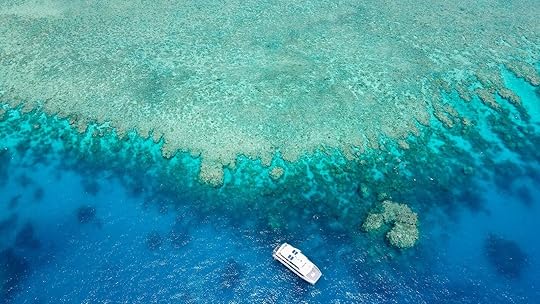
The Great Barrier Reef, the world’s largest coral reef system, is one of the main reasons to visit Australia. With world-class diving and snorkeling, glass-bottom kayaking, sailing, and scenic flights to choose from, there are activities to suit all adventure appetites. Finally, slumbering at reef level has been added to the list with an innovative and highly exclusive “sleep on the reef” concept by Journey Beyond.
Reef Suites and Reefsleep at Reefworld
Photo courtesy Journey Beyond
Reefsleep and Reef Suites are offered as two-day/one-night experiences onboard the Reefworld pontoon. This custom-built platform is an all-inclusive accommodation and tour experience floating on the Outer Great Barrier Reef, with transfers and meals as well as most beverages and activities included in the nightly rate starting at $670 AUD ($442) per person.
Pitched as Australia’s first underwater hotel, Reef Suites is a below-deck, immersive accommodation experience at the Great Barrier Reef. There are only two suites available – one king double and one twin room – both of which offer an uninterrupted view of the reef and its marine life through floor-to-ceiling glass panels. These en suite cabins have modern bathrooms, premium bedding, and air-conditioning. A television is the only item amiss, because who needs movies when you’re sleeping with the fishes?
On the other hand, Reefsleep is an above-deck experience where you’ll drift away under the stars in deluxe swag tents listening to the sound of waves. Although carefully spaced for privacy, these glamping accommodations are somewhat more sociable in style with shared bathroom facilities. All Reefsleep reservations include a trip to the underwater observatory, which mimics the design of Reef Suites.
Exclusive Great Barrier Reef activities with Reefworld
Photo courtesy Journey Beyond
Upon boarding Journey Beyond’s catamaran, you’ll embark on a scenic sailing trip through the Whitsunday Islands with plenty of time for snorkeling and swimming before checking into Reef Suites and Reef Sleep. A semi-submarine tour and access to the underwater observatory are part and parcel of all bookings, which ensures non-swimmers can encounter the underwater world. Meanwhile, helicopter flights over the nearby Heart Island and certified diving excursions are available at an additional cost.
Arriving at the Reefworld Pontoon in time for sunset, a lavish dinner prepared by the onboard chef is served under the night sky. Travelers may upgrade to an exclusive underwater dining experience for two or add Champagne and photo packages for an even more memorable experience.
Getting to Reefworld and when to visit
Photo: marcobriviophoto.com /Shutterstock
The Reefworld Pontoon is situated on Hardy Reef, about 40 nautical miles from Airlie Beach in the Whitsunday region of Queensland. Journey Beyond operates transfers from Airlie Beach, Daydream Island, and Hamilton Island.
The best time to visit Reefworld at the Great Barrier Reef is during the dry season, from May to October, when the skies are sunnier and water visibility is optimal. June and July are the best months for spotting whales passing through the Coral Sea. Queensland’s wet season, from November to April, is favorable to travelers seeking fewer crowds at the Great Barrier Reef. Regardless of the season, Australia’s most exclusive accommodation experience should be booked far in advance. 
13 Coastal Airbnbs Perfect for Escaping Winter Cold

It’s only September, but you know what’s coming. Some people embrace winter — they wax their skis, swaddle in wool, and insist they actually enjoy short, gray days. And then there are the rest of us, who know ourselves well enough to admit that by January we’ll be miserable. The light therapy lamp won’t be cutting it, our boots will always be wet, and every time we step outside, we’ll swear it’s the coldest we’ve ever felt.
If you fall into that camp, don’t let a warm-weather getaway be an afterthought. By the time December rolls around, all the best Airbnbs in sunny places will already be booked. Instead, plan ahead and give yourself something to look forward to — a midwinter escape where “layering up” means a billowing kaftan and the only hazardous ice is the oversized hipster cube in your cocktail. And luckily you don’t have to go far. From Mexico to California to Puerto Rico, these coastal Airbnbs are worth bookmarking now, so when the dark days hit, your escape plan is already in place.
We hope you love the spaces and stays we recommend! Just so you know, Matador may collect a small commission from the links on this page if you decide to book a stay. Listed prices are accurate as of the time of publication.
Bohemian beachfront home with deck and whale watching in Ventura, California Photo: Airbnb
Photo: Airbnb Photo: Airbnb
Photo: Airbnb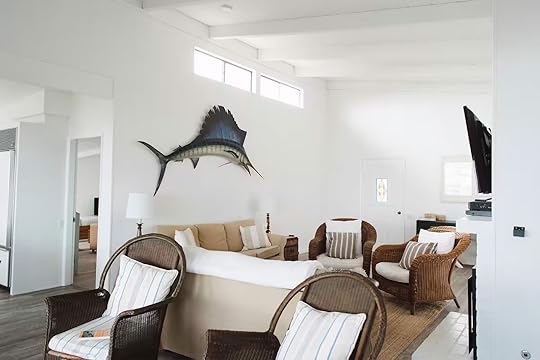 Photo: Airbnb
Photo: Airbnb Photo: Airbnb
Photo: AirbnbSee more photosBlending traditional and modern design, this house features oceanfront views and contemporary amenities from a superb location at Faria Beach. Get cozy inside this dreamy space and gaze out the large windows at the water, or watch the surf and look for wildlife like whales while getting some fresh air on the spacious private deck. The “beachy” feeling space emits a sense of relaxation and eclecticism, with nautical decor elements like seashells and light blue and whitewashed walls.
The living, dining and kitchen areas are oceanfront — meaning idyllic views. Make a meal in the fully equipped kitchen with a dishwasher and subzero refrigerator. There are two main bedrooms with clean and comfortable queen beds on the main level, and the sleeping space is in the family-style living room, with two twin beds and a couch, TV, and laundry machine.
Six guests, three bedrooms
Price: $930 per night
 Photo: Airbnb
Photo: Airbnb Photo: Airbnb
Photo: Airbnb Photo: Airbnb
Photo: Airbnb Photo: AirbnbSee more photos
Photo: AirbnbSee more photosPadre Island, also known as North Padre, is surprise, surprise, north of the laid-back South Padre Island near Brownsville, Texas. To complicate this further, I’m adding Mustang Island to the mix and suggest staying in Port Aransas. Mustang Island is accessible by a ferry from the north or a bridge from the top of Padre. The entire region deserves exploration, so base yourself in Port Aransas, bring or hire a vehicle, and allow yourself time to enjoy the miles of sandy beaches and the climate of the tropical southern tip of Texas.
One to bookmark, this is the ultimate beach house. You’ll be set up for success with a stay here as the hosts have thought of everything. Entertainment is sorted with the game room with arcade machines, outdoor games for the yard, and a private heated pool with an outdoor shower. There’s a built-in EV charger, complimentary beach gear, and the rental comes with a six-seater golf cart for zooming around the island.
12 guests, four bedrooms
Price: $750 per night
 Photo: Airbnb
Photo: Airbnb Photo: Airbnb
Photo: Airbnb Photo: Airbnb
Photo: Airbnb Photo: AirbnbSee more photos
Photo: AirbnbSee more photosAn hour north of Cabo but a world away in atmosphere, Todos Santos skips the resort sprawl in favor of cobblestone streets, colorful art galleries, and a distinctly bohemian pace. Winter brings clean Pacific swells that keep surfers paddling out at Playa Cerritos, while in town you can wander between craft coffee shops, taco stands, and small studios before catching one of Baja’s signature fiery sunsets.
Staying in Todos Santos usually means choosing between tucked-away casitas near the town’s galleries or modern villas with views of the Pacific. This three-bedroom home sits right at that intersection — close to shops and restaurants but perched above an arroyo with sweeping mountain and ocean views. The design blends contemporary lines with hacienda-style details, and each bedroom opens to the outdoors. A chef’s kitchen, shaded dining patio, and a lap pool for cooling off make it an easy base for exploring town or the beaches just down the road.
Six guests, three bedrooms
Price: $615 per night
The most sought-after ski-in/Ski-out Airbnbs in Big Sky Montana for groups and families The 63 Most Exciting New Hotels of 2024 Cliff House with stunning pool and waterfall view in Maui, Hawai’i
 Photo: Airbnb
Photo: Airbnb Photo: Airbnb
Photo: Airbnb Photo: Airbnb
Photo: Airbnb Photo: Airbnb
Photo: AirbnbSee more photos
Winter in Maui means peak humpback whale season. Every year, thousands of whales migrate from Alaska to the warm Hawaiian waters to give birth and raise calves, and sightings are almost guaranteed from December through April. The beaches around Kāʻanapali and Wailea are perfect for spotting spouts offshore, and guided whale-watching tours get you even closer to the action. Add in warm ocean temps for snorkeling, lush hikes through ‘Iao Valley, and the Road to Hana’s waterfalls — Maui delivers both adventure and relaxation in the middle of winter.
This epic cliff house, 300 feet above the ocean, encapsulates everything great about a stay on Maui. The ocean is right there, you have a private pool and hot tub, and you can relax over cocktails while gazing at the Hanehoi Waterfall. Hana is visible from the home, as is the north coast of Maui. Relax over a book next to the 10-foot marble fireplace, though focusing on the pages may prove to be a struggle with the scenery of paradise in the background. You’ll never have a better view from a hot tub, this we can guarantee. For more stunning Airbnbs on the island, check out Matador’s wider selection of Maui Airbnbs and other great finds on Hawai’i’s beaches.
Three guests, one bedroom
Price: $481 per night
 Photo: Airbnb
Photo: Airbnb Photo: Airbnb
Photo: Airbnb Photo: Airbnb
Photo: AirbnbOn Puerto Rico’s west coast, Rincón earns its reputation as the “surfing capital of the Caribbean.” From December to March, the waves are at their best, drawing surfers from around the globe. But it’s not just for board riders: the town is famous for golden sunsets, casual beach bars, and whale-watching along the coast. No passport needed for US travelers, and with warm evenings perfect for outdoor dining, Rincón offers an easy Caribbean getaway during the colder months back home.
In Rincón, many Airbnbs line the town’s surf breaks, ranging from simple beach apartments to larger villas with shared pools. This two-bedroom unit sits right on Dogman’s Beach, one of the area’s most famous stretches of sand, with Maria’s Beach just to the north and Steps Beach to the south. Inside, there’s an open kitchen and living space that opens onto a front patio with sunset views, while outside guests share access to a pool, gazebo, grills, and an outdoor bar. It’s an easy spot for surfers or snorkelers who want the water only steps from the door.
Four guests, two bedroom
Price: $175 per night
 Photo: Airbnb
Photo: Airbnb Photo: Airbnb
Photo: Airbnb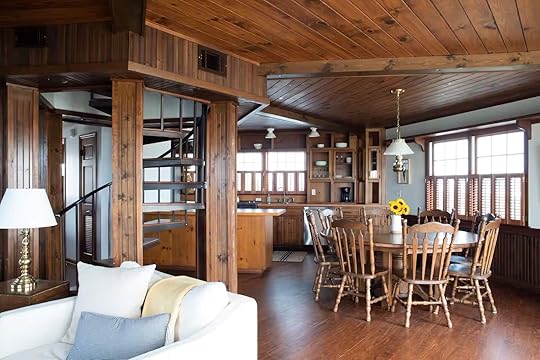 Photo: Airbnb
Photo: Airbnb Photo: Airbnb
Photo: AirbnbNorth of Jacksonville, Amelia Island is a stretch of Atlantic coastline that stays mild through the winter, with daytime highs that make the beach a year-round draw. Fernandina Beach is the hub, with historic streets, casual seafood spots, and easy access to the sand. The quieter vibe sets it apart from Florida’s bigger resort towns, and in winter it feels especially calm.
This beachfront lighthouse is just steps from the ocean at Fernandina Beach. The New England-style home has three bedrooms, a wrap-around deck, and uninterrupted views of the Atlantic Ocean.
Six guests, three bedrooms Price: $533 per night
Book NowLuxury retreat with rooftop deck and sunset views in Orange County, California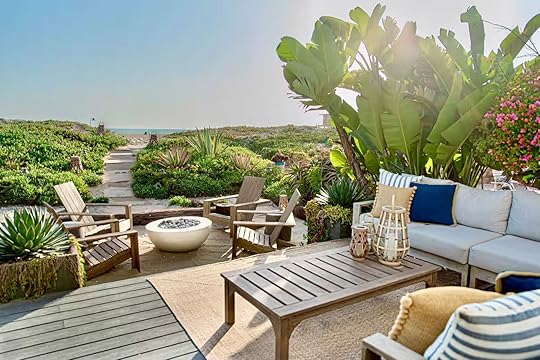 Photo: Airbnb
Photo: Airbnb Photo: Airbnb
Photo: Airbnb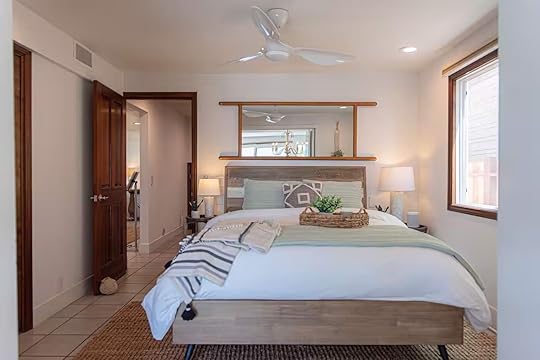 Photo: Airbnb
Photo: Airbnb Photo: Airbnb
Photo: AirbnbSee more photosTucked away between Huntington Beach and Seal Beach in a neighborhood dubbed “Sunset Beach,” this bohemian-feeling, peaceful seaside property was designed to give visitors a feeling of being transported to the tropical sands of Tulum. The stunning sunsets seen over the water will be breathtaking from each of the four levels to explore within this home that feels more like a resort.
Luxurious on-site at this property amenities include a Sonos sound system, a soaking bathtub, a bidet toilet system, a 3-car garage, and designer outdoor equipment, including beach bikes and bodyboards. Other amenities include a beachfront first-floor deck outfitted with a natural gas firepit and grill and enough lounge seating to fit everyone for an outdoor dining or stargazing session. There’s also a fully equipped kitchen with all the tools needed to create a tasty meal and three comfortable bedrooms — including a well-appointed primary suite.
Don’t miss the fourth-level rooftop deck, which is equipped with chaise lounges, a large sectional and 360-degree views—including the hills of San Pedro, the sparkling skyline of Downtown Long Beach, the Huntington Beach pier and Harbor, and, of course, the ocean.
Eight guests, three bedrooms
Price: $1,679 per night
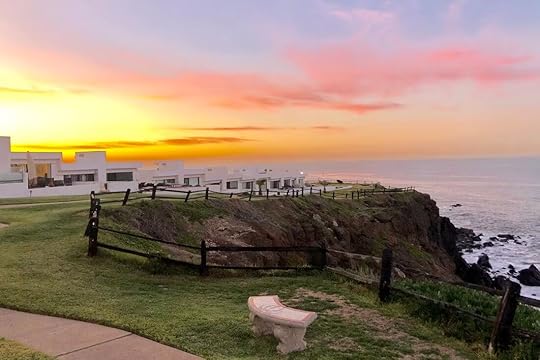 Photo: Airbnb
Photo: Airbnb Photo: Airbnb
Photo: Airbnb Photo: Airbnb
Photo: Airbnb Photo: Airbnb
Photo: AirbnbSee more photosThe crown jewel of this upscale, three-bedroom attached villa is likely the breathtaking ocean views from its enormous patio space overlooking the ocean. Listening to the sound of the waves below is the best way to relax within the recently remodeled, updated open-concept living spaces. Contemporary furnishings and amenities include high-speed internet access and a big flatscreen Smart TV in the living room. Cook in the modern kitchen, which features granite countertops, stainless steel appliances, and a water filter, in addition to a myriad of cooking tools and dinnerware.
The villa is a 5-10 minute walk from the festivities of downtown Rosarito, but peace and safety are paramount within the neighborhood due to a 24-hour security detail and gated community-only access. Other community-wide accessible amenities include a pool, sauna, spa and gym.
Six guests, three bedrooms
Price $185 per night
 Photo: Airbnb
Photo: Airbnb Photo: Airbnb
Photo: Airbnb Photo: Airbnb
Photo: Airbnb Photo: AirbnbSee more photos
Photo: AirbnbSee more photosTake the Californian chilled lifestyle, add a dash of European island vibes, and you get one heck of a combo. That’s Catalina in a nutshell. It reminds me of the South of France or the Amalfi, and with quick one-and-a-half-hour transfers from three ports in South California, it’s a lot easier for West Coasters to get to than Europe. There are two towns on the island, Avalon and Two Harbors. Those wanting to stay in Avalon will need to book in advance, even in winter. As you might expect, Airbnbs and other holiday rentals are a hot commodity.
This newly renovated cottage is beautifully decorated, and when you’re not at the beach club, you can chill in the spacious private outdoor yard and take in the views of the harbor. There are three bedrooms and two bathrooms, and the location is spot on. It’s a one-minute walk to the grocery store and three minutes to the harbor and restaurants.
Six guests, three bedrooms
Price: $1,036 per night
 Photo: Airbnb
Photo: Airbnb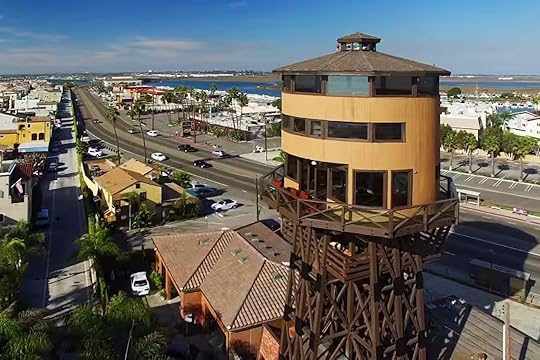 Photo: Airbnb
Photo: Airbnb Photo: Airbnb
Photo: Airbnb Photo: Airbnb
Photo: AirbnbSee more photosThis one-of-a-kind four-story, 87-foot Water Tower House is famed for its beautiful views and easy access to the local happenings of Seal Beach on the California coast. The structure itself dates back to 1892, initially serving as a source of water and power for Pacific Railway steam engines — but has since been converted into a home featuring three bedrooms, four baths, a family room, a dining area, and stunning views.
The elevator offers guests access to the first three levels. Up to the main level, admire the enormous windows with panoramic sights of the city and the scenery, and step out onto the wraparound deck, which has a jacuzzi. There’s a whimsical spiral staircase to reach the 4th and 5th Floors. The fully equipped kitchen has all the tools needed to make a yummy dinner, and the laundry facilities mean guests can extend their stay and keep fresh. The fifth floor features a well-appointed living room space with a bar, games, 360-degree views, and multiple Smart TVs for staying entertained any time of day or night.
Eight guests in four bedrooms
Price: $729 per night
 Photo: Airbnb
Photo: Airbnb Photo: Airbnb
Photo: Airbnb Photo: Airbnb
Photo: Airbnb Photo: Airbnb
Photo: AirbnbSee more photosThis tasteful, upscale oceanfront home sits on Hollywood Beach in Oxnard, a historically favorite spot for celebrities to relax in their beach home. But this personally customized house itself is brand new. The property sits right on the sand — and was completed in December of 2018, featuring luxurious amenities like an elevator, four 70′ inch smart TVs, and a master bedroom perched up on the third floor showcasing unobstructed, panoramic views of the water below.
Seemingly, every room in the house boasts an impeccable view of the ocean. Watch the waves roll in from the large windows looking out onto the water in the living room space, relax in the luxurious soaking tub in the master bathroom (which also features sights of the ocean), or get cozy on the couch in front of one of the enormous televisions. There’s a large kitchen with an island to gather around and share a meal, and balconies on each level of the home to enjoy the fresh sea air and sunshine.
Fourteen guests, five bedrooms
Price: $786 per night
 Photo: Airbnb
Photo: Airbnb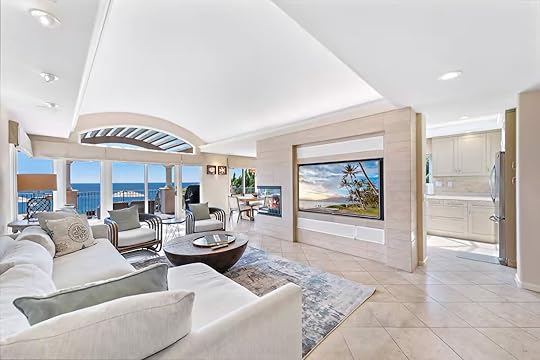 Photo: Airbnb
Photo: Airbnb Photo: Airbnb
Photo: Airbnb Photo: Airbnb
Photo: AirbnbSee more photosFeel like royalty in this large villa property boasting sweeping ocean views, an enormous patio, three bedrooms and two and one-half baths. Lounge out on the spacious, private, shaded veranda, which has a gas barbecue and chaise lounges. Rest in one of the comfortable and stylishly furnished bedrooms. Share a meal at the dining room table, surrounded by glass windows featuring sights of the blue sky and ocean below.
There’s a large skylight in the kitchen, letting in an abundance of natural light, and the stainless steel appliances and sleek countertops offer a great spot to make a home-cooked meal. Additional on-site amenities include a cozy gas fireplace, central air-conditioning, a large flat-screen TV, and a relaxing jetted tub in the master bath.
Eight guests, three bedrooms
Price: $1,069 per night
 Photo: Airbnb
Photo: Airbnb Photo: Airbnb
Photo: Airbnb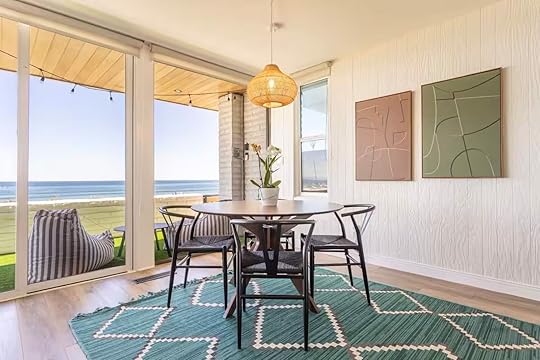 Photo: Airbnb
Photo: Airbnb Photo: Airbnb
Photo: AirbnbSee more photosThis clean, light-filled property is set on the iconic Strand in Manhattan Beach. Enjoy beautiful sea views and unparalleled beach access — just two elements that make this property feel exceptionally special. Gaze out the large windows onto the beach or step outside onto the balcony and breathe in the sea air.
Bright, modern design elements and a touch of vivid color in the furnishings add a bohemian flair to the otherwise minimalist decor. There’s a cozy living room with a large sectional, flatscreen TV, and a fireplace flanked by a wall of windows. The compact but functional kitchen has everything needed to make a home-cooked meal. It’s within walking distance of the sand and many shops and restaurants of downtown Manhattan Beach. 
Five guests, two bedrooms
Price: $512 per night
Matador Network's Blog
- Matador Network's profile
- 6 followers



